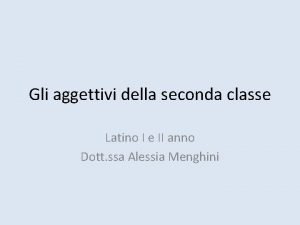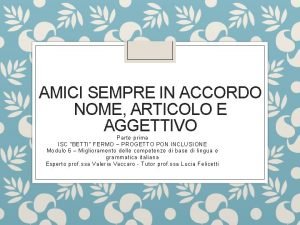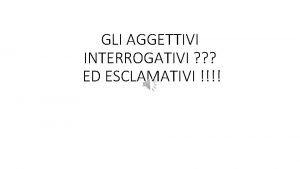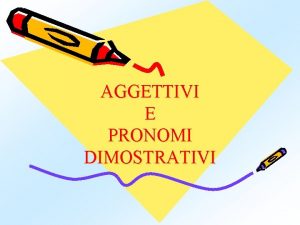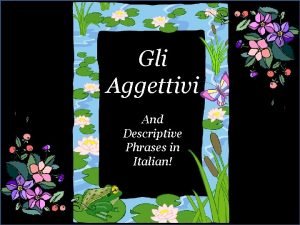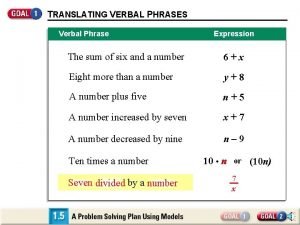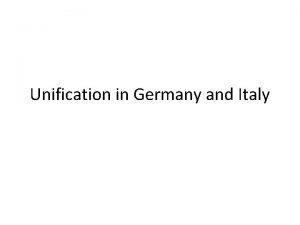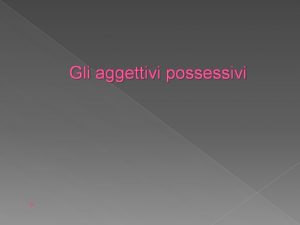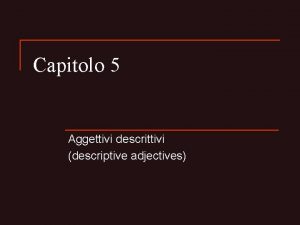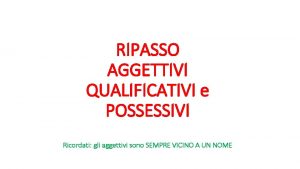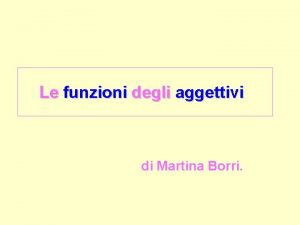Gli Aggettivi And Descriptive Phrases in Italian 1









- Slides: 9

Gli Aggettivi And Descriptive Phrases in Italian!

1. Adjectives are used to describe nouns. In Italian, the adjectives must agree in number and gender with the noun they modify. 2. Usually, the adjective follows the noun. For example: e l o g e re Lui è bravo. (He is great. ) Lei è brava. (She is great. ) s e l u r The Loro sono bravi. (They are great. ) L Anna ha gli occhi azzurri. (Anna has blue eyes. ) -Notice that the adjective follows the noun.

The Plurals of Nouns: Important reminders: Nouns ending in “O” The plural is “I” When changing a noun to the plural that ends in “cia” the ending is “ce” (the same for “gia” – changes to “ge”) Fratello – fratelli Libro – libri Vino – vini A noun ending in “ca” changes to “che” (the same for “ga” changes to “ghe”) Nouns ending in “A” The plural is “E” A noun ending in “co” changes to “chi” (the same for “go” changes to “ghi”) Casa – case Pizza – pizze Sorella - sorelle EXCEPTIONS: Nouns ending in “E” The plural is “I” Bicchiere – bicchieri Padre - padri Nouns of Greek origin that end in “ma” or “ta” change to “mi” or “ti” (ex. problema = problemi, poeta = poeti) Some nouns are invariable – the noun doesn’t change but the article does: il film = i film, la città = le città)

Putting it all together: Noun (s. ) Verb Adjective (s. ) The girl La ragazza is è pretty. bella. The boy Il ragazzo is è handsome. bello. The gender article + the gender noun + the (present tense/3 rd person verb) + the gender adjective = a proper sentence.

The Plurals The articles that precede the nouns must have the proper form of the plural “identifier. ” Il and lo (for masculine nouns) becomes “i” or “gli. ” i – nouns that begin with a consonant. gli – nouns that begin with a vowel, consonant blends, or “z” La (for feminine nouns) becomes “le. ”

Noun (pl. ) Verb (pl. ) Adjective (pl. ) The girls Le ragazze are sono pretty. belle. The boys I ragazzi are sono handsome. belli. Notice: the word for a young person is almost the same for boy and girl, what distinguishes it is the ending. Plural fem. Article + pl. fem. noun + pl. verb + pl. adjective = a properly pluralized Italian sentence!

Feminine nouns – their plurals and some adjectives. Eng. Subj. /Verb Eng. Adjective Italian Subj. Verb Italian Subj. /Verb (Note: the regular form of the adjective in ( ) is masculine. Singular is bold. The girls are: rich (ricco) –ricca Le ragazze sono: ricche sad (triste) –triste tristi thin (magro)-magra magre tall (alto)-alta alte pretty (bello)-bella belle serious (serio)-seria serie patient (paziente) –paziente pazienti creative (creativ 0)–creativa creative intelligent (intelligente)- intelligente intelligenti

Masculine Nouns – their plurals and some adjectives. Eng. Subj. /Verb Eng. Adjective Italian Subj. Verb Italian Subj. /Verb The boys are: rich – (ricco) I ragazzi sono: ricchi creative (creativo) creativi tall (alto) alti sad (triste) tristi intelligent (intelligente) intelligenti (Special Note: Whereas the fem. adjectives changed their endings in agreement with the feminine nouns and followed the same rules as for nouns, the masculine adjectives generally change only from their “o” or “e” ending to “i” because the masculine form is the regular form of the noun. It still follows the same rule as the nouns. )

Next Week: Continuare con gli aggettivi, di colore, e gli aggetivi possessivi. Homework for next class: Write 10 sentences in the singular using adjectives. Then rewrite them in the plural. Be prepared to share!
